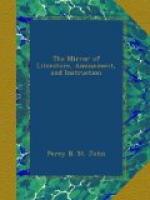* * * * *
Notes of a Reader.
* * * * *
SIR WALTER SCOTT’S NEW WORK.
We detach this little descriptive gem from Sir Walter Scott’s “Anne of Geierstein,” just published. An outline of this very delightful novel will be found in a SUPPLEMENT with the present number of the MIRROR.
“The ancient tower of Geierstein, though neither extensive, nor distinguished by architectural ornament, possessed an air of terrible dignity by its position on the very verge of the opposite bank of the torrent, which, just at the angle of the rock on which the ruins are situated, falls sheer over a cascade of nearly a hundred feet in height, and then rushes down the defile, through a trough of living rock, which perhaps its waves have been deepening since time itself had a commencement. Facing, and at the same time looking down upon this eternal roar of waters, stood the old tower, built so close to the verge of the precipice, that the buttresses with which the architect had strengthened the foundation, seemed a part of the solid rock itself, and a continuation of its perpendicular ascent. As usual, throughout Europe in the feudal times, the principal part of the building was a massive square pile, the decayed summit of which was rendered picturesque, by flanking turrets of different sizes and heights, some round, some angular, some ruinous, some tolerably entire, varying the outline of the building as seen against the stormy sky.”
* * * * *
THORWALDSEN.
Since the death of his illustrious contemporary, Canova, Thorwaldsen, born at Copenhagen in 1771-2, has occupied the public eye as head of the modern school. The character and powers of this master are doubtless of a very elevated rank: but neither in the extent nor excellence of his works, do we apprehend his station to be so high as sometimes placed. The genius of the Danish sculptor is forcible, yet is its energy derived more from peculiarity than from real excellence. His ideal springs less from imitation of the antique, or of nature, than from the workings of his own individual mind—it is the creation of a fancy seeking forcible effect in singular combinations, rather than in general principles; therefore hardly fitted to excite lasting or beneficial influence upon the age.




